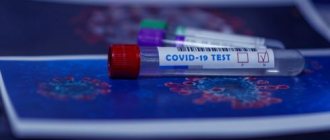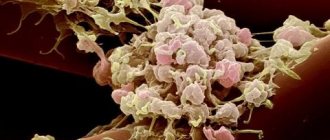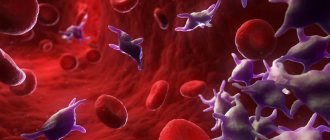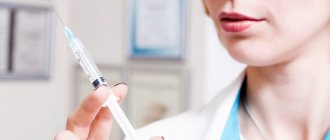Complexes with this research
Check-up No. 1 for children and adolescents Annual preventive examination program 10,950 ₽ Composition
Women's check-up No. 1 38 studies for an annual preventive examination 19,290 ₽ Composition
Biomarkers of liver functional capacity RUB 2,760 Composition
IN OTHER COMPLEXES
- Biochemistry of blood. 19 indicators 6,280 ₽
- Biochemistry of blood. 13 indicators 3,490 ₽
- Men's check-up No. 1 RUB 18,570
- Healthy interest RUB 4,250
- Preventive check-up 6,300 ₽
Results
The liver is an intermediary between the gastrointestinal tract, which receives various substances, and the human body as a whole. The liver is the organ that is directly involved in metabolism.
Liver enzymes AlT, GGT, AST help it cope with various harmful substances, neutralizing them. While the liver is healthy, people do not try to help it maintain its normal condition. They begin to pay attention to the organ only after it is damaged to one degree or another. Until that point in time, a person poisons his liver for many years.
If liver tests and enzymes increase, you should think about the state of your health and continue the examination in order to try to eliminate the pathology in time.
Author of the article:
Shutov Maxim Evgenievich |
Hematologist Education: Graduated from Kursk State Medical University in 2013 and received a diploma in General Medicine. After 2 years, he completed his residency in the specialty “Oncology”. In 2021, she completed postgraduate studies at the National Medical and Surgical Center named after N.I. Pirogov. Our authors
Detailed description of the study
The study shows the level of gamma-glutamyl transferase activity in the blood serum. Used to diagnose pathologies and assess the functions of the liver, biliary tract, and pancreas.
Gamma-GT (gamma-glutamyltransferase) is a microsomal enzyme that plays the role of a catalyst for some biochemical processes. In cells, the enzyme is found in the membrane, cytoplasm and lysosomes. Most of the gamma-GT is secreted by the cells of the liver and pancreas. It is also produced in the prostate, spleen, kidneys and brain, but in smaller quantities.
An increase in the level of gamma-GT in the blood is observed during pathological processes in these organs, as well as due to alcohol abuse. The synthesis of the enzyme is stimulated by the use of certain drugs, for example, paracetamol and phenobarbital - while taking them, the activity of gamma-GT in the blood may increase. Also, a high concentration of the enzyme in the blood serum is observed in infants under 6 months.
The test is more sensitive for detecting cholestasis than determining the activity of ALT and AST, and can detect pathology earlier than other tests. In this case, the analysis is recommended to be used for a comprehensive assessment together with such indicators as ALT, AST, alkaline phosphatase, total bilirubin.
Why is the research being conducted?
The liver is the largest organ in the human body, which performs many important functions:
- participates in the digestion process. The liver produces bile, which ensures the change from gastric to intestinal digestion,
- neutralizes the effects of allergens and toxic substances;
- regulates carbohydrate, lipid, protein metabolism;
- removes excess hormones and vitamins from the body;
- synthesizes immunoglobulins and antibodies;
- stores and distributes glucose and glycogen;
- replenishes the supply of certain vitamins.
However, the liver is capable of fully performing these functions only in the absence of pathologies. Liver tests - a biochemical blood test consisting of many laboratory tests - allow you to assess the condition of the organ.
The test is rarely carried out as a preventive measure. Most often, tests are prescribed if the doctor suspects that the patient has liver problems. For example, a referral for a study can be issued to those who have symptoms characteristic of liver pathologies - yellowness of the skin and sclera, pain in the right hypochondrium, sudden weight loss, nausea, vomiting, and the appearance of a sour-bitter taste in the mouth. In addition, the study is used to track the results of treatment of liver pathologies.
The indicators included in the liver tests reflect not only the functioning of the liver, but also other organs and systems - the heart, kidneys, intestines, thyroid gland, skeletal muscles. Therefore, the study may also reveal disorders not related to liver function.
Transcription of analyzes online.
cost of service: 500,300 rubles
Order
General practitioner Khanova Irina Ivanovna will interpret your tests during an online call in the Zoom or WhatsApp application.
- detailed explanation from the general practitioner.
- an alternative opinion from a competent specialist in interpreting the analyses.
- the opportunity to ask questions to the doctor regarding test results.
References
- Clinical guidelines for the diagnosis and treatment of cholestasis. Russian Gastroenterological Association Russian Society for the Study of the Liver, 2013
- Clinical recommendations “Alcoholic liver disease”: - Scientific Society of Gastroenterologists of Russia, Russian Scientific Medical Society of Therapists, 2021.
- Letter of the Ministry of Health of the Russian Federation dated November 2, 2021 N 15-4/10/2-7675 On the direction of clinical recommendations (treatment protocol) “Acute fatty liver degeneration in pregnant women: intensive care and obstetric tactics”, 2021.
- Anesthesia and intensive care for acute fatty liver degeneration in pregnant women Clinical guidelines. Treatment protocol: - Kulikov A.V., Shifman E.M., 2015
How the analysis is carried out, GGT norm indicators
To determine a person's GGT level, a blood sample will be required. It is taken in the morning, when the subject has not yet taken food, since after it enters the body, enzymes that can change the blood picture will be activated. It is important to abstain not only from food, but also from water.
The purity of the experiment is influenced by the incubation temperature of the sample, so you can see the temperature in degrees Celsius on the form. This makes it possible to distinguish normal indicators from pathological indicators obtained at different temperatures.
The norm values depend on the person’s age and gender. All of them are presented in the table.
| A person's age and gender | Normal value at a temperature of 37 °C Celsius in U/ I (U/l) |
|
|
|
|
| Newborns in the first 5 days of life | Up to 185 |
Children
|
|
It should be taken into account that in the conditions of one laboratory, the same reference values may be taken as normal indicators, and in the conditions of another laboratory – slightly different indicators. Therefore, the limits of the norm need to be clarified in each specific institution where blood was drawn. Although, as a rule, there is no significant discrepancy in these readings.
Hyperlipoproteinemia - symptoms and treatment
Diet
If the patient has no symptoms, then treatment begins with a special diet.
Correction of nutrition can reduce cholesterol levels by 5–10%. Recommended:
- Eat less animal fat (up to 30% of daily calories).
- Include vegetable oils in your diet: sunflower, olive and cottonseed (up to 25–30 mg per day). They are a source of polyunsaturated fatty acids, which normalize cholesterol metabolism.
- Eat fewer foods rich in cholesterol: liver, kidneys, brains, fatty meats, egg yolks, mayonnaise, fatty sauces.
- Do not fry the meat, but boil it, but avoid very rich broths.
- Eat no more than 40–50 g of sugar per day, limit consumption of sweets, cakes, pastries, sugary drinks and fruit nectars. Excess sugar contributes to the development of atherosclerosis.
- Drink freshly squeezed juices from apples, oranges and carrots 1-2 times a week.
- Do not indulge in strong tea and coffee, as they can increase blood pressure, cause palpitations and insomnia.
- Eat no more than 3–5 g of salt per day.
- There are more vegetables, fruits, cereals (especially rolled oats) and wholemeal products.
- Eat fish twice a week, steaming or grilling it.
- Season salads with olive oil, lemon juice, herbs and spices [3].
It is important to remember that cholesterol not only comes from outside, but is also formed in the body. Therefore, you should not completely give up foods containing fats.
Drug treatment
For cardiovascular diseases, diabetes mellitus, chronic kidney disease and a high risk on the SCORE scale, cholesterol-lowering medications are indicated. However, in some cases, patients even at moderate risk may require drug therapy. It will help reduce the likelihood of developing atherosclerosis.
To correct the level of atherogenic lipids, drugs are taken for a long time, most often for life. When LDL levels are reduced, the risk of cardiovascular disease decreases by 30–40% [9].
Groups of drugs for the treatment of hyperlipoproteinemia:
- statins;
- fibrates;
- inhibitors of cholesterol absorption in the intestine;
- bile acid sequestrants;
- PCSK9 enzyme inhibitors;
- n-3 fatty acids [8].
Statins
Statins (Atorvastatin, Rosuvastatin, Pitavastatin) are the most effective drugs for lowering cholesterol. They block the enzyme that is involved in its formation and thereby suppress the production of cholesterol in the liver. Statins reduce low-density lipoprotein (LDL) and triglycerides (TG).
Statins prevent the development of atherosclerosis of the coronary and cerebral arteries, and with long-term use they reduce the size of plaques in the vessels. These drugs are necessary for patients with hyperlipoproteinemia and atherosclerosis for the prevention of myocardial infarction and stroke.
Before you start taking statins, it is necessary to determine the lipid profile, and also check the condition of the liver based on the content of liver enzymes (ASAT, ALAT) in the blood. Statins are used in safe dosages until target LDL levels are achieved. The dosage depends on the patient's cardiovascular risk.
To assess the safety and effectiveness of the prescribed dose, a month after starting treatment, it is necessary to re-test the lipid profile, AST and ALAT. The effect appears within the first week from the start of treatment. After two weeks it is 90% of the maximum effect. The greatest effect is achieved by the fourth week and then remains constant.
If the target LDL level is reached and the drug does not adversely affect the liver, then the statin at this dosage is used for a long time. The lipid profile, ASAT and ALAT are monitored every 3–6 months. When liver enzymes increase above three norms, the drug is no longer used.
Target levels for lowering LDL cholesterol depend on cardiovascular risk [7].
| Cardiovascular risk | Lower LDL |
| High | ≥ 50% of baseline to 1.4 mmol/l |
| Moderate | 2.6 mmol/l |
| Short | 3.0 mmol/l |
In addition to lowering cholesterol, statins have a positive effect on the condition of the inner lining of the arteries, stabilize atherosclerotic plaques and improve blood flow.
Statins are generally well tolerated, but some patients experience side effects such as muscle pain. The drugs should be taken under the constant supervision of a doctor, their dose should be adjusted in a timely manner or used in combination with other medications.
Fibrates
Fibrates (Fenofibrate) stimulate the activity of the enzyme lipoprotein lipase and thereby accelerate the breakdown of lipoproteins. They reduce not only cholesterol, but also triglycerides (TG). These are the drugs of choice for patients with diabetes, who most often have elevated TG.
Inhibitors of cholesterol absorption in the intestine
Cholesterol absorption inhibitors (Ezetimibe) are used as second-line therapy in combination with statins. They are prescribed if it is not possible to reduce lipoprotein levels to target levels, as well as if it is impossible to take statins [5].
Bile acid sequestrants
Sequestrants (Cholestyramine, Colestipol) are ion exchange resins that prevent bile acids from being absorbed in the intestine. Depletion of these acids activates their synthesis from cholesterol in the liver. Used in patients with cholestasis.
Taking drugs in this group often causes side effects: flatulence, stool retention, nausea, pain or discomfort in the upper abdomen, which limits their use.
Monoclonal antibodies
PCSK9 inhibitors (Alirocumab, Evolocumab) are monoclonal antibodies that bind to LDL receptors in the liver and stimulate the breakdown of lipoproteins. They are administered subcutaneously, usually once every 2 weeks or once a month, depending on the drug. Prescribed to patients with a very high risk of cardiovascular disease and when it is impossible to take statins [7].
N-3 fatty acids
To reduce the level of triglycerides and lipoproteins (especially VLDL), you can take eicosapentaenoic acid and docosahexaenoic acid. The exact dosage is determined by the doctor [8].
It is important to prescribe lipid-lowering therapy on time to prevent the development of atherosclerosis and its complications.
Why are the numbers falling?
A decrease in such an indicator as glutamine aminotransferase is quite rare. And it is due to one of three reasons:
- What are triglycerides in a biochemical blood test?
- Hypothyroidism is a pathological condition of the thyroid gland in which it produces an insufficient amount of hormones - thyroxine and triiodothyronine - which leads to a malfunction in the body's metabolic processes,
- Use of certain medications
- GGT is reduced in patients undergoing treatment for alcohol addiction after a month of therapy.
How is GGT tested?
The GGT study is included in the biochemical blood test and is included in the group of liver tests. For the determination, human biological material (blood) is used, which is donated on an empty stomach, since with the consumption of food there is an increase in enzyme activity, which will lead to false results.
Blood is drawn from a vein.
It is very important to follow all the preparation steps before having a blood test so that you do not have to do it again.
The GGT level is recorded at different temperatures of the incubation sample and using different methods. The choice of method and temperature used depends directly on the laboratory in which the patient is tested and the equipment installed in them.
As a result of the analysis, next to the GGT indicator the temperature at which the study was carried out is noted. So, deciphering the analysis can only be done by an experienced doctor, since in addition to the temperature and method of examination, it is necessary to take into account the gender, age, and race of the patient.
To avoid false indicators in the final results table, it is recommended to follow preparation measures. By following the rules listed below, the results will be the most reliable, which will help to correctly diagnose or refute the disease.
The main recommendations for preparation are:
- ACCP for rheumatoid arthritis: norm, analysis, interpretation
- Blood is donated on an empty stomach. To avoid deviations in blood counts caused by activation of enzymes due to food intake. The consumption of foods is limited at least eight hours (preferably more than ten) before the time of blood sampling. That is why the test is taken in the morning, since a person will not feel hungry at night. It is also prohibited to drink any drinks, including ordinary drinking water,
- Refuse to eat fatty, highly salted, spicy, overcooked foods that are difficult for the body for at least twenty-four hours (preferably forty-eight hours). Such products have too strong an effect on enzymes, significantly increasing the indicators
- to stop playing sports and avoid strenuous physical activity as much as possible , two days in advance, since physical effects on the body also affect the final results,
- A visit to a sauna, steam bath, or hot bath the day before can lead to fluctuations in normal values. You should avoid visiting places where the body is exposed to thermal effects,
- Limit alcohol intake and cigarette consumption at least 24 hours before the upcoming test.
- Stop using medications at least two days before the test. Drugs of certain groups can affect the parameters of a biochemical blood test. If it is not possible to stop using medications, you must inform your doctor about the use of medications. The doctor will make adjustments to the results, taking into account the effect of a particular drug on human blood,
- Come to donate blood 10-15 minutes in advance . This is necessary so that the body calms down, shortness of breath goes away, and the body acclimatizes to the temperature conditions of the room (especially after a cold street).
Fact! If you are very hungry, it is better to take food with you and satisfy your hunger immediately after blood collection.
What could affect the results?
In addition to liver disorders, the following factors may affect a normal result, leading to a false reading. These include:
- Long-term use of ascorbic acid can significantly reduce the GGT result,
- Elevated GGT levels are provoked by antibiotics, antidepressants, oral contraceptives, aspirin, paracetamol, testosterone and certain types of medications,
- Excessive excess weight.
Fact! When deciphering the analysis, it is also important to take into account other indicators in the biochemical blood test (lipase, LDH, bilirubin, ALT, AST, etc.), since almost all GGT deviations are accompanied by disturbances in the levels of other enzymes. ALT and AST are elevated, then the pathology is confirmed.
Reasons for reducing GGT
Thyroid pathology can cause a decrease in GGT
There are not many reasons for a decrease in GGT; it is mainly due to endocrinological pathology of the thyroid gland:
- Congenital underdevelopment of the thyroid gland;
- Hereditary disorder of the synthesis of thyroid hormones;
- Autoimmune diseases of the thyroid gland associated with a decrease in its function (hypothyroidism);
- Conditions after surgery on the thyroid gland;
- Lack of iodine in food.
What can lead to improved results, besides diseases?
Elevated gamma-glutamyltransferase levels can be caused by alcohol abuse on the eve of a blood test. It was also previously mentioned that some drugs can affect the results of the study, inflating the actual values.
Such medicines include:
- barbiturates;
- statins are a group of drugs used to lower blood cholesterol levels;
- antidepressants;
- some types of antibiotics;
- oral contraceptives and some other hormonal drugs;
- Aspirin, Paracetamol.
Also noted is the fact that in obese individuals the level of the enzyme will be higher than normal. The doctor should take this into account when interpreting the study results.
When is a test to determine GGTP prescribed?
The determination of this type of transferase can be prescribed separately or in combination with other liver enzymes, for example, aspartate aminotransferase or alanine aminotransferase, to diagnose the condition of the hepatobiliary tract.
This enzyme has great diagnostic value in diagnosing diseases of the liver and biliary tract in such categories of people as children and pregnant women, since other liver enzymes increase at a physiological level.
Glutamyl transpeptidase activity also increases when the liver is exposed to toxic substances, such as certain medications or alcohol. This way you can understand whether the liver damage was caused by alcohol or not.
Glutamyltransferase is not found in bones. Accordingly, the level of GGT will not be affected by bone tissue pathology. This allows us to search for reasons for the increase in another enzyme - alkaline phosphatase.
Alkaline phosphatase is a diagnostic indicator of bone tissue pathology or damage to the hepato-biliary system.
GGT also makes it possible to assess the state of the kidneys, and if their functioning is disrupted, this enzyme will indicate this to the doctor.
Thus, gamma-glutamyltransferase makes it possible to carry out differential diagnosis of conditions that cause disruption of the liver, pathology of the kidneys and biliary tract.
Preparing for analysis
How to prepare?
The determination of gamma-glutamyltransferase refers to a number of biochemical blood tests. In order to obtain accurate information about GGT in the body, the patient must properly prepare for blood donation.
The preparation rules are very simple:
- For biochemical studies, blood should be donated on an empty stomach, that is, after an overnight fast for 10–12 hours. This way you can be sure that the blood will be suitable for research and will reflect the exact content of the test indicator in the blood;
- It is recommended not to smoke for several hours before blood collection;
- emotional experiences a day before the analysis can affect the accuracy of the research results;
- training and other physical overload of the body should be cancelled. They can also affect the final result;
- If the patient is prescribed medications, then you should consult a doctor - can they affect the level of the enzyme in the blood? The patient should not cancel or prescribe anything on his own!
Where is it for rent?
Blood sampling to determine the level of glutamyl transferase takes place in a special room at a medical institution. Most often this is a local clinic. This simple analysis can also be carried out in private medical organizations.
Price
When visiting a clinic at your place of residence, the determination of gamma-glutamyl transferase is carried out free of charge for patients with a compulsory medical insurance policy. If the patient expressed a desire to donate blood to determine the level of this enzyme in a private medical center, then the price for this analysis will be about 150 - 300 rubles.
Please remember that there is an additional charge for the blood collection procedure itself. On average, this will be about 150 – 300 rubles, depending on the region.











